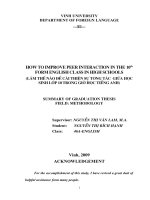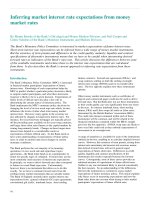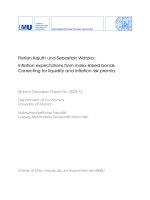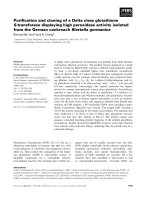Low competence EFL leaners’ expectations from their class = Những mong muốn của học sinh yếu khi học tiếng Anh trên lớp. M.A Thesis Linguistics: 60 14 01 11
Bạn đang xem bản rút gọn của tài liệu. Xem và tải ngay bản đầy đủ của tài liệu tại đây (1.04 MB, 76 trang )
VIETNAM NATIONAL UNIVERSITY, HANOI
UNIVERSITY OF LANGUAGES AND INTERNATIONAL STUDIES
FACULTY OF POST-GRADUATE STUDIES
*********************
LÊ THỊ MỸ PHONL
LOW-COMPETENCE EFL LEARNERS’ EXPECTATIONS FROM
THEIR ENGLISH CLASS
Những mong muốn của học sinh yếu khi học tiếng Anh trên lớp
M.A MINOR THESIS
FIELD: ENGLISH TEACHING METHODOLOGY
CODE: 60140111
Hanoi, 2014
VIETNAM NATIONAL UNIVERSITY, HANOI
UNIVERSITY OF LANGUAGES AND INTERNATIONAL STUDIES
FACULTY OF POST-GRADUATE STUDIES
*********************
LÊ THỊ MỸ PHONL
LOW-COMPETENCE EFL LEARNERS’ EXPECTATIONS FROM
THEIR ENGLISH CLASS
Những mong muốn của học sinh yếu khi học tiếng Anh trên lớp
M.A MINOR THESIS
FIELD: ENGLISH TEACHING METHODOLOGY
CODE: 60140111
SUPERVISOR: NGUYỄN TRƯỜNG SA, Ph.D.
Hanoi, 2014
DECLARATION OF AUTHORSHIP
I, Lê Thị Mỹ Phonl, declare that this graduation thesis is original and has not
been submitted for assessment elsewhere.
I declare that this assignment is my own work and does not involve
plagiarism or collusion.
Signature:
Date: September 5, 2014
ACKNOWLEDGEMENTS
I would like to take this opportunity to express my sincere thanks and
appreciation to all those who contribute and support to the completion of this
study.
My deepest appreciation goes to my supervisor, Dr. Nguyen Truong Sa,
from whom I have gained expert guidance and personal inspiration. I
especially thank him for his ongoing support and constructive comments on
early versions of the manuscript. His private time for me was so valuable that
I do not know how to repay.
I am grateful to Ms Chi - the general director of ALIS for accepting me
to investigate at ALIS and for her helps in arranging classes for me. Many
thanks are sent to the teachers and learners who took much time and great
care into my study. I am indebted to my two colleagues: Ms Tuyet and Mr Tin
for all supports when I needed.
Finally, a heartfelt gratutide I feel towardmy beloved family for their
emotional and material support. They really mean the world to me.
i
ABSTRACT
This study examined expectations of 5 low-competence learners in a
private English school in Vietnam. The researcher adopted two qualitative
methods of in-depth interview and observation to collect the data. The first
in-depth interview data was coded to build up the subjects‟ stated
expectations. To examine their expectations related to what happened in
class, the researcher analyzed the data collected from the observations and
second in-depth interviews. The results showed that the low-competence
learners cherished many expectations of the learning activities, the teachers
and the classmates since they were not satisfied and had many challenges
when learning in class. The effective collection and value to teachers of
English were discussed.
ii
TABLE OF CONTENTS
DECLARATION OF AUTHORSHIP
ACKNOWLEDGMENTS .......................................................................................... i
ABSTRACT ................................................................................................ii
TABLE OF CONTENTS ..................................................................................... iii
DEFINITIONS OF TERMS ................................................................................vi
LIST OF ABBREVIATIONS ...............................................................................viii
TRANSCRIPTION CONVENTIONS .................................................................. ix
LIST OF TABLES AND FIGUERS ....................................................................... x
PART A: INTRODUCTION
1. Rationale ..................................................................................................... 1
2. Objectives of the study ..................................................................................2
3. Research questions .........................................................................................2
4. Significance of the study ............................................................................. 3
5. Context of the study ................................................................................... 3
6. Overview of chapters ................................................................................. 4
PART B: DEVELOPMENT
CHAPTER 1: LITERATURE REVIEW ......................................................... 6
1.1. Expectations.............................................................................................. 6
iii
1.1.1. Definition of expectations ............................................................ 6
1.1.2. Categories of expectations ............................................................... 7
1.1.3. Approach to expectations ....................................................................8
1.1.3.1. Expectations, experiences and challenges ...................................8
1.1.3.2. Expectations andbehaviors ........................................................11
1.2. Low-competence learners .........................................................................11
1.3. Approach to study expectations in language learning ............................12
CHAPTER 2: METHODOLOGY .....................................................................16
2.1. Participants .................................................. ..............................................16
2.2. Data collection ...........................................................................................18
2.2.1. Data collection instruments ................................................................18
2.2.2. Data collection procedures ................................................................19
2.2.3. Data analysis procedures ...................................................................22
2.3. Role of researcher .....................................................................................23
2.4. Trustworthiness and Credibility ...............................................................24
2.5. Ethical considerations ...............................................................................24
2.6. The pilot study ...........................................................................................24
CHAPTER 3: FINDINGS AND DISCUSSION ..............................................26
3.1. Pre-conceived expectations ......................................................................26
iv
3.2. Learning behaviors ....................................................................................31
3.3. Learning challenges ..................................................................................34
PART C: CONCLUSION
1. Conclusions of the study ..............................................................................36
2. Pedagogical implications .............................................................................37
3. Limitations of the study and Suggestions for further study........................38
REFERENCES .................................................................................................40
APPENDIX A: A GUIDE FOR DESIGNING AND CONDUCTING
IN-DEPTH INTERVIEW ........................................................ I
APPENDIX B: LEARNING ACTIVITIES .................................................. IV
APPENDIX C: QUESTIONS FOR THE FIRST IN-DEPTH INTERVIEWS
...................................................................................................V
APPENDIX
D:
QUESTIONS
FOR
THE
SECOND
IN-DEPTH
INTERVIEWS.................................................................................................. VI
APPENDIX E: INTERVIEW SAMPLE ...................................................... VII
v
DEFINITION OF TERMS
Behaviors
Behaviors are a collection of actions a person does that can be observed,
measured, and repeated (Bicard & Bicard, 2012). In line with them, behaviors
used in this study are what students do, respond and react when learning in
class.
Challenges
Challenges referred in this study are learners‟ difficulties when learning
English in class and unsatisfied factors about their class.
Competence
Competence is an entity of theoretical knowledge, ability, application
knowledge, behavior and motivation structured in mastering a specific situation
(Gilbert, 1998). I used the term “low competence learners” throughout the study
to define those individuals whose abilities, knowledge and skills of English are
performed worse than others in class classified by their teachers according to
their result of performance in tests and classroom.
English as a foreign language (EFL)
EFL described situations where students were learning English in order to
use with any other English speakers in the world (Harme, 2007) and where
English is taught as a subject in schools but not used for communication within
the country (Richard at al., 1992).
Expectations
Expectations in this study are defined as desires or wants of language
vi
learners. Expectations are based on a person‟s previous language learning
experience, goals, and needs, and may influence how individuals react,
respond, and experience in practice (White, 1999; Barcelos, 2000).
Experiences
Experiences are the interaction, adaptation, and adjustment of
individuals to the environment (Dewey, 1938; Barcelos, 2000). Experiences,
as I used in this study, are what students interact, adapt and adjust to their
class.
vii
LIST OF ABBREVIATIONS
ALIS: Atlantic Languages and Informatics School
EFL: English as a Foreign Language
viii
TRANSCRIPTION CONVENTIONS
01, 02
speaker turn
S
student
I1
the first interview
I2
the second interview
ix
LIST OF TABLES AND FIGURES
Figure 1: Expectation disconfirmation paradigm .............................................. 10
Table 1: Data collection schedule ...................................................................... 22
Table 2: Data analysis strategies for the research questions ............................... 23
Table 3: Summary of collected data .................................................................. 26
Table 4: Summary of pre-conceived expectations ............................................. 28
x
PART A: INTRODUCTION
1. Rationale
Since Vietnam open-door policy came into existence in 1986 through the
economic renovation known as Doi moi, English has emerged as the most
important language. An increasing influx of foreign investment has brought
Vietnamese people about the need to learn English. English has gained its role
as the main foreign language taught and used in the country (Wilson, 1993a).
Thus, most Vietnamese learners have had at least seven years studying
English as a compulsory subject in secondary and tertiary levels. However,
they are often not able to use English for communication outside the
classroom. As a result, the increasing number of them is likely to go to private
English schools for extra English classes with expectations to be taught in
magical ways to improve their English (Nguyen, 2012) although tuition fees
paid for such classes are very high. Accordingly, hundreds of language
centers have been mushrooming all over the country, and thus, the market in
English education has become more competitive than ever.The current
climate suggests that learners spending a substantial sum of money on
learning English are now seen as primary customers (Hill, 1995). Such
situations are likely to give a rise to specific expectations in learners regarding
the process and outcome of English learning and the fulfillment of these
expectations becomes the goal of any English teaching and learning
programs. In other words, if teachers are framed as service providers, then one
way to ensure the provision of a quality service is to know the expectations of
customers as they enter into the service transaction (Zeithaml et al., 1990).
Nguyen (2012) also notes that when students are treated as customers, and the
market in English education becomes more competitive, then serving
1
Vietnamese learner‟s beliefs and expectations becomes the goal of teaching
and the primary requirement for the teachers is satisfying their learner‟s
expectations. Besides, as suggested by Trejo (2007) understanding learners‟
expectations is essential for effective teaching and learning because those
expectations are likely to have a strong influence on their learning process.
Yet within the field of applied linguistics we know relatively little about the
expectations of learners (Trejo, 2007; Bordia et al., 2006).
In public schools in Vietnam, as students are taught English to achieve
high grades in paper exams, many teachers are normally worried about the
present of lower proficiency learners in their classes. However, as the number
of such lower learners is usually much fewer than the average and higher ones
in each class, it seems that attention from teachers on them is thus much
cursory. Unfortunately, in real sense such problem is inevitable as even if we
are able to assemble a class of complete beginners, it will soon be clear that
some are learning slower than others (Harme, 2007). Noticeably, although
there have increasingly been researches on students‟ expectations, very few
of them have focused on low-competence ones. Therefore, it is both practical
and significant to the literature in the field to investigate expectation of lowcompetence English learners in their classes.
2. Objectives of the study
The primary purpose of this study is to investigate low-competence
students‟ expectations from their English class. I will explore learning
activities that these learners expect to do in class; exam what happen in class
and if the students have any learning challenges; discover factors that make
them unsatisfied when learning in class.
2
3. Research Questions
The general question of this study is: What are low-competence EFL
learners‟ expectations from their English class? This question can be clarified
by addressing these specific questions.
(1) What expectations do these learners hold about their class?
(2) What are their learning behaviors?
(3) What are challenges of these learners when learning in class?
4. Significance of the study
Practically, my study‟s outcome can help teachers with some new
experience on low-competence students as well as bring a careful
consideration into their teaching methods. In addition, it also draws teacher
to look back their teaching process in class, recognize their shortages and
provides them with some ways to improve the quality of their teaching and
their students‟ learning as well. My study aims to facilitate teachers who are
worried about their low-competence students, want to give their students the
hands full of care and opportunities for their improvement and development,
and are seeking for documents and information of low-competence students‟
expectations. Theoretically, this study will contribute to the current literature
by relating low competence students‟ expectations concerned by many
teachers and researchers, but in the lack of experience and database.
5. Context of the study
The site of this study is ALIS (Atlantic Languages and Informatics
School), one of the most prestigious private English schools in Bình Tân
district, Hồ Chí Minh city. Reasons for choosing this school related to
3
practical issues, the purposes of my study, and the research questions. First of
all, despite having to pay much higher fee, EFL learners are likely to go to
private schools for extra English classes where their expectation is a major
factor in decisions about how and what to teach. When students are treated as
customers, their expectations become the goal of the schools and the primary
requirement for the teachers is satisfying their learner‟s expectations. It was
hoped that in a private school where the focus was on teaching for business
rather than teaching and learning for tests, I would be able to gain more
reliable and significant data. The research was carried out at ALIS. It is a
private school located 686 Le Trong Tan street, Binh Hung Hoa ward, Binh
Tan district, Ho Chi Minh city, Viet Nam. With the staff of nearly 20
experienced, qualified and knowledgeable teachers, ALIS is now training
more than seven hundred students differing from ages to levels. As other
private schools, ALIS deliveries students many courses including: Lets Go
(English for kids), Solutions (English for teenagers), American English File
(Communicative English for adults), Pronunciation, SMF (Starters-MoversFlyers), PET, KET and TOEIC. For learning facilities, ALIS provides
computer labs, movies rooms and well-equipped classrooms with TVs, CD
players, computers and air-conditioners in order to create the best learning
environment for students. Generally, the school has many things in common
with other private schools like curriculums, course books, students and
policies. Most of the students here are still pupils and university students, only
a few of them have had a job. At the school, the students are treated as
customers, so their expectations of English learning and teaching are at the
highest rate. Secondly, to examine a group of learners and teachers in depth
as well as to achieve extensive observation of classes, it was a good strategy
to concentrate on just one school. Generally, the school has many things in
4
common with other private schools like curriculums, course books, policies or
students. Then I strongly believed that the school would be a sample and able
to represent others. Therefore, ALIS where my data are collected with high
practicability and correctness is chosen as a context of my study.
6. Overview of chapters
I have introduced the research rationale, my objectives, and the research
questions. I argue that it is significant, especially from a practical perspective,
to study learners‟ expectations in the context of private schools in Vietnam. In
part B, chapter 1 is the literature review, which discusses the nature of
expectations, how to approach to low-competence learners as well as
summarize critically previous studies into expectations in the light of their
purposes, methods, and results; chapter 2 is the detail of my methodology;
and chapter 3 offers my results, discussion and interpretation of the findings.
In part C, the conclusions, limitations of the study and suggestions for further
study are available.
5
PART B: DEVELOPMENT
CHAPTER 1: LITERATURE REVIEW
Looking at historical and current trends, we researchers see that studies
of student expectations seem vital in fulfilling learners‟ needs effectively
(Bordia et al., 2006). Hill (1995) suggested that expectations of students are
valuable data which should be collected and analyzed. The interest in
examining learners‟ expectations is taken into many scholars‟ considerations
and reflected in a number of studies (Sander et al., 2000; Kuh et al., 2005;
Bordia et al., 2006; Kandiko & Mawer, 2013; Brindley, 1984; Nunan, 1988a;
Peacock, 1997; White, 1999; Trejo, 2007; Spratt, 1998; Mancuso et al., 2010;
Alcorso &Kalantzis, 1985; Barkhuisen, 1998; Green, 1993). This part sets
readers up from the general to specific comprehension of review of literature
of expectations.
1.1. Expectations
1.1.1. Definition of expectations
Defining expectation is not a simple task. From a small-scale view,
expecting something means to look forward to its probable occurrence or
appearance, as adapted from the American Heritage Dictionary of the English
language. From a view of social sciences, expectations are described as
subjective probabilities of the occurrence of future events (Bearden and Teal,
1983; Boulding et al., 1993). Meanwhile, many scholars (White, 1999;
Barcelos, 2000; Bordia et al., 2006) suggested that expectations are forms of
beliefs about the future. Therefore, it is now and then believed that expectations
are as ambiguous as their origins. Thus, we had better take a broader look back
at the history of the service management literature to fulfill our curiosity of
6
expectations. It is true that the concept of customer expectations has been
viewed in multiple ways. Zeithaml et al. (1993) said that expectations are
predictions made by customers about what is likely to happen during an
impending transaction or exchange. Prakash (1984) viewed expectations as
customers‟ hopes or desires about service providers. While there are many
obvious differences between consumer expectations and those of students,
there are some significant similarities. Bordia et al. (2006) reviewed the
literature and noted that there are some significant similarities between
consumer expectations and those of language learning. Hence, many
researchers borrowed from extensive work on expectations in the consumer
psychology literature to approach on learners‟ expectations. Gonyea (2005)
described learner‟s expectation as “something the student believes will
happen, anticipates doing or experiencing” (p.2). With the same point of
view, Oettingen & Mayer (2002) stated leaners‟ expectation is the form of
thinking about the future or, in other words, students‟ belief about the future.
Supporting the purposes of my study and the research questions, Prakash‟s
(1984) definition of expectation seems to be the best one for my study. Thus,
expectations in this study are defined as desires or hopes of language learners.
1.1.2. Categories of expectations
Above-mentioned definitions set us a path to understand expectations
through their categories. In the commercial world, expectations have been
seen as composite construct (Sander et al., 2000). Prakash (1984) and
Thompson & Sunol (1994) suggested three types of expectations. They
asserted that “ideal expectations” are what a customer would ideally like to
occur, “predictive expectations” are what the customer assumes to be
probably going to occur and “normative expectations” evolve from
7
experience of service provision by other similar service providers. In the
market of language education, Baldwin et al. (1997) demonstrated the three
following types of learners‟ expectations.
“Ideal expectations” are what learners believe should happen in
teaching and learning.
“Predictive expectations” are what they believe will happen.
“Counter-ideal expectations” are what they definitely did not want to
happen.
“Ideal expectations” and “predictive expectations” are also referred to as
“will” expectations, i.e. whether something will happen and “should”
expectations, i.e. whether something should happen, respectively (Boulding et
al. 1993).
1.1.3. Approach to expectations
After giving expectations serious consideration, it can be seen that
expectation is a mental state, which means approaching to learners‟
expectations is not a simple task. In the previous studies, a leaner‟s
expectations would be made clear by analyzing his/her experiences,
challenges and behaviors. Researcher should focus on the classroom level since
the result of Trejo‟s investigation (2007) suggested that the classroom is where
learning success or failure is determined. The nature of expectation and these
approaches strongly determine how I design my research study, and I will
discuss it in more detail in the next chapter.
1.1.3.1. Expectations, experiences and challenges
8
According to Barcelos (2000), experiences are the interaction,
adaptation, and adjustment of individuals to the environment. Throughout life
our experiences have a big impact on our expectations of what may happen
next since our experiences shape how we think, feel and act. Different
learners might base on previous and current language learning experiences
and future goals and need to cherish different expectations for how language
should be taught and learned (Barcelos, 2000; Barkhuizen, 1998; Bernat,
2008). Munford (1983) contended that “management educators should
research the learning process and help improve learning by providing a
learning process tailored to individual needs” (p. 17). By exploring the link
between expectations and experiences, Kuh et al. (2005) concluded who
students were less important to engagement, achievement, and persistence than
they expected from college and subsequently experience. Trejo (2007) focused
on the classroom level to examine student‟s expectation of teachers. The
voices captured in the study offered valuable information about students‟
expectations. Spratt (1999) investigated what English language learning
classroom activities learners liked, and then compared these preferences with
the activity preferences that the teacher provided in class.Braxton et al. (1995)
found empirical support for the effect of student expectations on students‟
successful integration into the academic and social aspects of campus. They
argued that the more congruence or “fit” there was between a student‟s
expectations and the experiences offered by the institution the more likely the
student was to persist in his or her studies. Expectations, according to Kuh et
al. (2005), form the basis for a kind of implicit contract between an individual
and, in this context, the institution in which he or she participates in order to
gain experience and skills. Students choose a learning context in part because
they feel that their choice will offer them more in terms of educational gain and
9
personal or career advantage. If the gained experience fails to live up to
expectations, this contract is broken, or at least stressed, and such stress is
always a hindrance to continuing engagement.
As a consequence, it is
important to understand not only whether initial experiences match up to
expectations but also whether those experiences are being realistically
evaluated or simply suffer in comparison to expectations (Mancusoet al.,
2010). To illustrate this, I refer readers to the following paradigm.
Perceived
Performance
(P)
Negative
Disconfirmation
P
Expectations
(E)
Dissatisfaction
Confirmation
P
Satisfaction
Positive
Disconfirmation
P>E
Enhanced
Satisfaction
Figure 1: Expectation Disconfirmation paradigm (Prakash, 1984)
This Prakash‟s (1984) paradigm can help us understand the process of
expectation disconfirmation and predict variables shaping expectations and
significant outcomes of disconfirmation. The first thing we have to consider
from the paradigm is that expectations are compared with performance of the
product or service and result in confirmation or disconfirmation of the
expectations. In education area, teachers are becoming framed as service
providers, students as customers and performance, of course, as students‟
learning experiences in class. Confirmation, as shown by the paradigm,
10
happens when a class performs as expected and leads to satisfaction.
Disconfirmation can be positive or negative. Positive disconfirmation happens
when the class is better than expected and leads to enhanced satisfaction.
Negative disconfirmation happens when the class is less than expected and
leads to dissatisfaction. As a matter of fact, on the journey of accumulating a
wealth of learning experience, students are not without facing significant
challenges from both outside and inside. As mentioned above, dissatisfaction,
for instance, happened when their class is less than expected. From another
aspect, these challenges reflected clearly what students are expecting from
their class.
1.1.3.2. Expectations and behaviors
In fact, a person‟s expectations are reflected by behaviors; White (1999)
and Barcelos (2000) and Oettingen and Mayer (2002) suggested that
expectations influence how individuals react, respond, and experience in
practice. In their argument, it is not a cause-effect relationship but a
relationship where understanding contextual constraints helps understanding
expectations since behaviors through gestures and facial expressions are a
mirror image of what is dominating people‟s expecting deep in their mind for
the time being. As discussed previously, expectations are metal and
individual; behaviors, meanwhile, are a collection of actions a person does
that can be observed, measured, and repeated (Bicard & Bicard, 2012).
Eventually, so as to read between the line people‟s expectations, it is widely
known that their behaviors should be actually observed.
1.2. Low-competence learners
Gilbert (1998) defined competence as an entity of theoretical knowledge,
11









